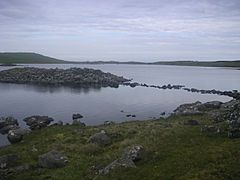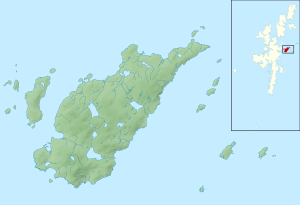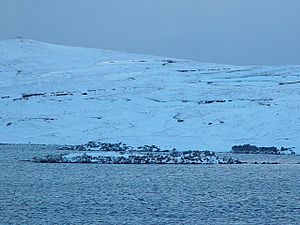Huxter Fort facts for kids
Quick facts for kids Huxter Fort |
|
|---|---|
| Whalsay, Shetland Islands, Scotland | |

Connected to the shore by a stone built causeway
|
|
| Coordinates | 60°20′18″N 0°59′24″W / 60.338211°N 0.989912°W |
| Site information | |
| Condition | Ruined |
| Site history | |
| Built | Iron Age |
| Materials | Stone |
Huxter Fort is an old fortification (a strong building for defense) found on Whalsay island. Whalsay is part of the Shetland islands in Scotland. This fort was built a very long time ago, around 300 BC, during the Iron Age. It sits on a small island in the middle of the Loch of Huxter (a loch is a lake). A stone path, called a causeway, connects the fort to the land.
When Was Huxter Fort Built?
Experts believe Huxter Fort was built around 300 BC. This was a time when many similar forts were made in the area. Huxter Fort looks a lot like other ancient forts. Examples include the Crosskirk Broch and the Ness of Burgi fort. It also shares features with the blockhouse at the Broch of Clickimin.
These forts were likely built by people who shared a similar culture. There are even some similarities with stone forts in western Ireland. One example is the Dunbeg Fort in County Kerry. Huxter Fort is older than two other forts on Whalsay. Those forts, called brochs, were built closer to the year 0 AD.
Huxter Fort was still standing well into the 1800s. When people described it in 1879, it was in much better shape than it is today.
What Does Huxter Fort Look Like?
To get into the fort, you would cross the stone causeway. Then, you would go through a narrow passage. This passage had small rooms on either side. There was a doorway in the middle of this entrance section. This design is similar to the blockhouse at Clickhimin.
The entrance passage is quite narrow. It is only about 2.5 feet (0.76 meters) wide at the start. It gets a bit wider inside, reaching about 3.5 feet (1.07 meters). Some people think there might have been a two-story wooden building inside the fort. This building would have been built against the inner wall.
Today, there isn't much proof of this wooden building. However, old descriptions of the fort suggest it might have been there. Other ancient forts also show signs of what could have been inside stairways.
A strong stone wall goes all the way around the small island. A special two-room building, called a blockhouse, forms the main defense. This blockhouse is located opposite the causeway. The ring wall seems to have been built separately from the main blockhouse. The blockhouse is part of the wall, but it isn't fully joined to it.
The defenses of this fort might seem a bit weak. This could be because there were extra defenses made of wood or thorny branches. These would have disappeared over time. Another idea is that the defenses were mostly symbolic. Perhaps warfare back then followed certain rules or rituals.



